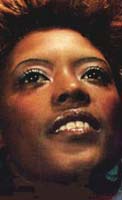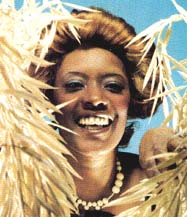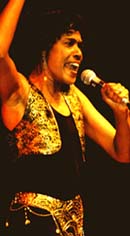|
||||||||||
If
you have come to this page through a frame, |
||||||||||
After a second 45 "Give Me Some Credit", which was a fair-sized hit, Ann's first album "This Is Ann Peebles" was issued. In contrast to her subsequent LP's, Ann did not write or co-write any of the material. Besides covers of Otis Redding's "Respect", Aretha Franklin's "Chain of Fools" and Fontella Bass's "Rescue Me", the album contained the track Ann had sung at the Club Rosewood "Steal Away", written by Percy Sledge's cousin Jimmy Hughes (who had enjoyed a big hit with it in 1964) and the beautiful "Bowlegs" Miller composition "Won't You Try Me". Backing Ann here, and on virtually all of her Hi-output, were Hi's rhythm section, an incredibly tight group of Memphis musicians who simply were known as Hi Rhythm. The drummer, Howard Grimes, who is still active today, was a protégé of the late Al Jackson Jr., of Booker T. & the MGs fame. Al, who played on many Hi-sessions, had an exquisite style of drumming, that can be heard on innumerable Hi, Stax and other Southern Soul recordings. Then there were the amazing Hodges brothers; Mabon "Teenie" (guitar), Charles (organ) and Leroy (bass). Hi Rhythm were often assisted by Willie Mitchell's son Archie Turner on keyboards and the Memphis Horns (Andrew Love, Wayne Jackson, James Mitchell, Jack Hale. Ed Logan and Lewis Collins). "We're still close, close friends and I think that Hi-Rhythm was the ingredient that was put into Hi Records and when I say ingredient I mean, every musician made up a different flavor there", Ann said. "Charles Hodges did certain things on the organ that was so distinctive and no one could deny 'that's the Hodges Brothers, that's Charles on the organ, that's Teeny on guitar and Howard Grimes on drums and Leroy Hodges on bass'. All four of them made up the ingredient that was needed and I think they were very special for that time. They cut so many different hits. The Hi sound had a whole lot to do with that rhythm section." Another vital component in the 'Hi sound' were backing singers (Sandra) Rhodes, (Charlie) Chalmers & (Donna) Rhodes. "They were from Nashville and they would come down to Memphis to put the background on. A lot of times I'd be on the road when they came in to put the backgrounds to my songs. But Willie and Don already knew exactly what I wanted on there. Usually Don would put down like a scratch vocal, so when they came in he would direct them to do what we wanted on there. So it always worked out for me. Rhodes, Chalmers & Rhodes were on just about every artist's record on Hi and they were accustomed, they had gotten used to each artist's style and that's what I really liked about them."
"Straight from The Heart", followed in 1972 and yielded four hit singles "I Pity The Fool", "Slipped, Tripped and Fell In Love", Somebody's On Your Case" and "Feel Like Breaking Up Somebody's Home". This masterpiece was specifically written for Ann by Al Jackson Jr. (who also played on the song) and Timothy Matthews, with a little help from Stax-writer Deanie Parker. There were many fine album tracks too, including Don Bryant's "99 lbs." ("99 pounds of natural-born goodness y'all, 99 pounds of Soul"). "At the time, a lot of people were talking about her being 99 lbs. and you know, I was admiring her in my own way", Don said. "I thought it would be a good idea to come up with a song that would be directly relating to her and the '99 lbs.' was perfect. Usually when I'm writing for someone, I try to tell as much about that artist as I can, after talking with them, watching them work, things like that. But '99 lbs.' was really about how I felt for her." Don chuckled, before adding; "She was '99 lbs. of pure goodness', and still is." If that declaration of love wasn't proof enough that Ann and Don had by now overcome their differences, they also wrote "Trouble, Heartaches And Sadness" and "I've Been There Before" together. Another memorable song on "Straight From The Heart" is "What You Laid On Me" which Ann wrote with her good friend Denise Craig, better known as Denise LaSalle. Ann says she and Denise -who just happens to be another of this scribe's favorite southern Soul heroines- also "did some TV shows together". Denise's link to Hi went back to the late sixties, when this independent lady had just started her own production company called Crajon. Denise signed artists, wrote songs for them, and when it came to the recording part, she frequently brought her acts down to Willie Mitchell in the Royal studio. When Denise got her own deal with Westbound Records in 1971, she chose to work with Willie, who, together with Ann's "discoverer" Gene "Bowlegs" Miller, arranged Denise's fine debut LP "Trapped By A Thing Called Love". On the excellent follow-up from 1973 "On The Loose", Hi Rhythm, Rhodes, Chalmers & Rhodes and the Memphis Horns too grace the credits.
|
||||||||||
|
|
|||||||||
© Maria Granditsky
March 1998. |
||||||||||
Home - Artists - What's New - Links - FAQ - Theme - About Me |
||||||||||

 Ann, who had sung all her
life and had all the stage experience in the world, found the recording process exciting.
In 1968, just some four months after "Bowlegs" Miller brought Ann to Willie
Mitchell and Hi, she was already cutting what would become her very first single. "It
was very, very new to me. Just to be in a studio.. And record! It was so different, so
very different from what I had imagined it would be. To hear yourself like that, on
microphone and to hear yourself in a studio, there's a whole different sound there".
In 1969, producer Willie Mitchell felt that Ann was ready for the world (and that the
world was ready for her). He was right. Her debut, "Walk Away"
shot to an impressive #22 spot on Billboard's Top 100 R&B singles charts in April.
"That was written by Oliver Sain, as a matter of fact, he wrote both 'Walk Away' and
the flipside 'I Can't Let You Go'. Oliver called Willie Mitchell and told him he knew me
and my father, and that he had two songs that he thought I could really do."
Ann, who had sung all her
life and had all the stage experience in the world, found the recording process exciting.
In 1968, just some four months after "Bowlegs" Miller brought Ann to Willie
Mitchell and Hi, she was already cutting what would become her very first single. "It
was very, very new to me. Just to be in a studio.. And record! It was so different, so
very different from what I had imagined it would be. To hear yourself like that, on
microphone and to hear yourself in a studio, there's a whole different sound there".
In 1969, producer Willie Mitchell felt that Ann was ready for the world (and that the
world was ready for her). He was right. Her debut, "Walk Away"
shot to an impressive #22 spot on Billboard's Top 100 R&B singles charts in April.
"That was written by Oliver Sain, as a matter of fact, he wrote both 'Walk Away' and
the flipside 'I Can't Let You Go'. Oliver called Willie Mitchell and told him he knew me
and my father, and that he had two songs that he thought I could really do."  After
the promising start of her career, Ann's third single "Generation Gap"
mysteriously sunk without a trace. But in the fall of 1970, "Part Time Love",
a song that had been a hit for Little Johnnie Taylor seven years prior, went to #7 R&B
and #45 Pop. An LP had to be produced, but since there was not enough material in the
vaults, Hi re-packaged Ann's debut "This Is Ann Peebles" and called it
"Part Time Love". Both "Part Time Love" and "Generation Gap"
(which did not appear on "This Is Ann Peebles"), plus those singles' respective
B-sides were added to the set and the remaining six tracks were lifted from Ann's previous
LP. Worth noting is that the funky b-side of "Generation Gap", "I'll Get
Along", was co-written by Ann.
After
the promising start of her career, Ann's third single "Generation Gap"
mysteriously sunk without a trace. But in the fall of 1970, "Part Time Love",
a song that had been a hit for Little Johnnie Taylor seven years prior, went to #7 R&B
and #45 Pop. An LP had to be produced, but since there was not enough material in the
vaults, Hi re-packaged Ann's debut "This Is Ann Peebles" and called it
"Part Time Love". Both "Part Time Love" and "Generation Gap"
(which did not appear on "This Is Ann Peebles"), plus those singles' respective
B-sides were added to the set and the remaining six tracks were lifted from Ann's previous
LP. Worth noting is that the funky b-side of "Generation Gap", "I'll Get
Along", was co-written by Ann.  "Straight From The Heart" is a
truly wonderful album, but it would be Ann's second 45 from her next effort that would
take her all the way to the top. 1973 began with a Top 40 R&B hit, prolific Hi staff
writer Earl Randle's "I'm Gonna Tear Your Playhouse Down" and
in August that year, "I Can't Stand The Rain", the song that
would forever become Ann's signature, followed. "I Can't Stand The Rain" went
all the way to #6 on the R&B charts in the U.S. (entering the U.K. charts twice, in
the spring of '74) and is Ann's biggest hit to date. Like every record Ann made for Hi, it
was cut in Hi's Royal studio on 1320 South Lauderdale Avenue in Memphis, Tennessee, named
so after the Royal Theater Cinema it had originally housed. Royal had been rather humbly
equipped in the late sixties and it's amazing to think about that many of the now-classic
Hi recordings were made on what Ann called "a big, old, ugly eight track
machine". But by 1973, that had changed and Royal were proud owners of one of the
newest inventions on the market. This gizmo was used to imitate the sound of falling
raindrops in "I Can't Stand The Rain". "That was an electric timbale",
Ann revealed. "We were the first people to use it, at least in that order. When we
were recording something, we usually played the tape back and maybe we'd take something
off, like the first bars, and listen to it. Then we'd take the bass off and listen to it
and so on. Sometimes we'd take off everything and just listen to the voice to see if we
had every note that we wanted. At first, we had the timbales all the way through the song
but as we played the tape, Willie Mitchell said 'what about if the timbales were in front
before anything else comes in?'. So we did that and when we listened back I said 'I love
it, let's do that'. That's how that came about, everybody agreeing. During that time
period, Hi was really like a family, with the musicians, Willie Mitchell the
producer/engineer and all the writers. If one person heard something and everybody agreed,
then we'd do it and I think that's how Hi came to be as big as it did. Because it was like
a close-knitted family."
"Straight From The Heart" is a
truly wonderful album, but it would be Ann's second 45 from her next effort that would
take her all the way to the top. 1973 began with a Top 40 R&B hit, prolific Hi staff
writer Earl Randle's "I'm Gonna Tear Your Playhouse Down" and
in August that year, "I Can't Stand The Rain", the song that
would forever become Ann's signature, followed. "I Can't Stand The Rain" went
all the way to #6 on the R&B charts in the U.S. (entering the U.K. charts twice, in
the spring of '74) and is Ann's biggest hit to date. Like every record Ann made for Hi, it
was cut in Hi's Royal studio on 1320 South Lauderdale Avenue in Memphis, Tennessee, named
so after the Royal Theater Cinema it had originally housed. Royal had been rather humbly
equipped in the late sixties and it's amazing to think about that many of the now-classic
Hi recordings were made on what Ann called "a big, old, ugly eight track
machine". But by 1973, that had changed and Royal were proud owners of one of the
newest inventions on the market. This gizmo was used to imitate the sound of falling
raindrops in "I Can't Stand The Rain". "That was an electric timbale",
Ann revealed. "We were the first people to use it, at least in that order. When we
were recording something, we usually played the tape back and maybe we'd take something
off, like the first bars, and listen to it. Then we'd take the bass off and listen to it
and so on. Sometimes we'd take off everything and just listen to the voice to see if we
had every note that we wanted. At first, we had the timbales all the way through the song
but as we played the tape, Willie Mitchell said 'what about if the timbales were in front
before anything else comes in?'. So we did that and when we listened back I said 'I love
it, let's do that'. That's how that came about, everybody agreeing. During that time
period, Hi was really like a family, with the musicians, Willie Mitchell the
producer/engineer and all the writers. If one person heard something and everybody agreed,
then we'd do it and I think that's how Hi came to be as big as it did. Because it was like
a close-knitted family."